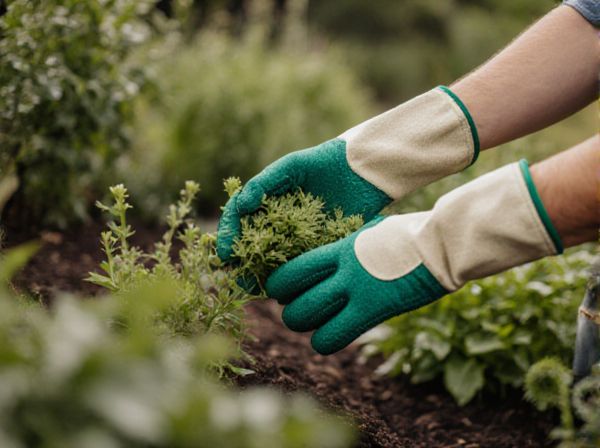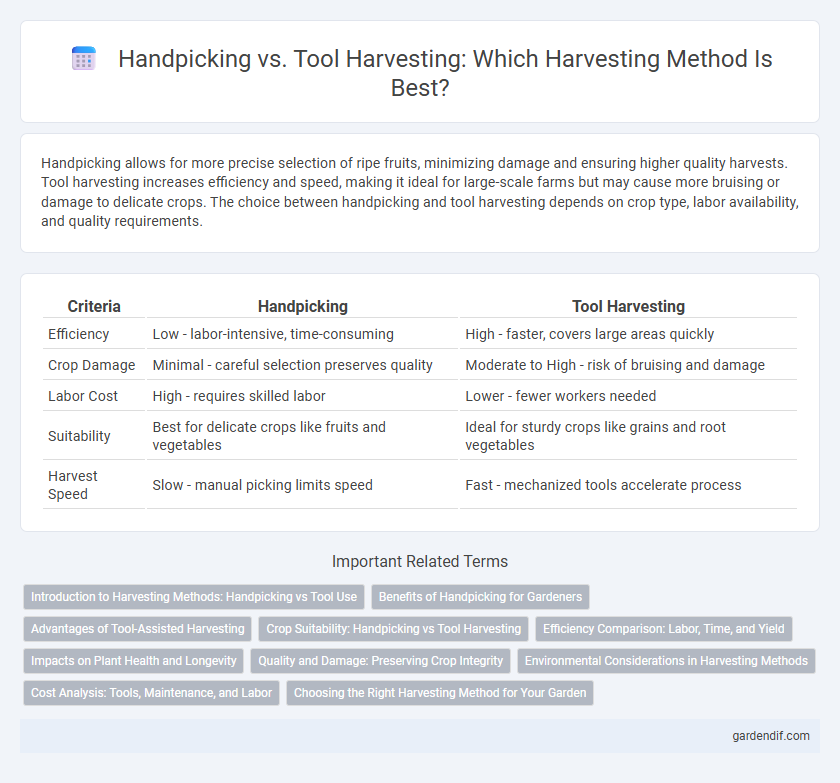
Handpicking vs tool harvesting Illustration
Handpicking allows for more precise selection of ripe fruits, minimizing damage and ensuring higher quality harvests. Tool harvesting increases efficiency and speed, making it ideal for large-scale farms but may cause more bruising or damage to delicate crops. The choice between handpicking and tool harvesting depends on crop type, labor availability, and quality requirements.
Table of Comparison
| Criteria | Handpicking | Tool Harvesting |
|---|---|---|
| Efficiency | Low - labor-intensive, time-consuming | High - faster, covers large areas quickly |
| Crop Damage | Minimal - careful selection preserves quality | Moderate to High - risk of bruising and damage |
| Labor Cost | High - requires skilled labor | Lower - fewer workers needed |
| Suitability | Best for delicate crops like fruits and vegetables | Ideal for sturdy crops like grains and root vegetables |
| Harvest Speed | Slow - manual picking limits speed | Fast - mechanized tools accelerate process |
Introduction to Harvesting Methods: Handpicking vs Tool Use
Handpicking harvest allows for precise selection of ripe crops, reducing damage and maintaining fruit quality, especially in delicate produce like berries and grapes. Tool harvesting, such as using mechanical or manual implements, increases efficiency and scalability, making it suitable for larger farms and harder-to-pick crops like root vegetables or grains. Choosing between handpicking and tools depends on factors like crop type, farm size, labor availability, and desired quality standards.
Benefits of Handpicking for Gardeners
Handpicking allows gardeners to selectively harvest only ripe fruits and vegetables, ensuring optimal quality and taste. This method reduces damage to delicate plants by avoiding mechanical stress, promoting healthier growth and longer yields. Precise handpicking also minimizes waste and helps detect early signs of pests or diseases, supporting sustainable gardening practices.
Advantages of Tool-Assisted Harvesting
Tool-assisted harvesting significantly increases efficiency by reducing the time and labor required compared to handpicking. Mechanical tools minimize crop damage and improve consistency in picking quality, ensuring higher market value and reduced post-harvest losses. Advances in ergonomic designs also enhance worker comfort and safety, making tool-assisted harvesting a profitable and sustainable choice for modern agriculture.
Crop Suitability: Handpicking vs Tool Harvesting
Handpicking is ideal for delicate crops like berries, tomatoes, and grapes where gentle handling preserves quality and reduces damage. Tool harvesting suits sturdier crops such as root vegetables, corn, and grains, enabling faster collection but potentially causing more physical stress to plants. Selecting the appropriate method depends on crop sensitivity, harvest scale, and quality requirements.
Efficiency Comparison: Labor, Time, and Yield
Handpicking offers precision harvesting with minimal crop damage but requires significantly higher labor input and time compared to tool harvesting, which increases efficiency through mechanization. Tool harvesting reduces labor costs and accelerates the process, often leading to higher yields by enabling quicker collection during optimal ripeness. However, the choice between methods depends on crop type and scale, as some delicate fruits may suffer yield loss from mechanized tools.
Impacts on Plant Health and Longevity
Handpicking allows for selective harvesting that minimizes damage to plant tissues, promoting healthier regrowth and extended longevity of the plant. Tool harvesting, while efficient, often causes physical injuries like cuts or bruises that can expose plants to diseases and stress, potentially reducing their lifespan. Careful handling during harvest is crucial to maintain plant vigor and ensure sustainable crop production.
Quality and Damage: Preserving Crop Integrity
Handpicking ensures superior crop quality by minimizing bruising and mechanical damage, preserving the natural texture and flavor of delicate fruits and vegetables. Tool harvesting, while faster and more efficient for large-scale operations, often increases the risk of cuts and abrasions that compromise crop integrity and shelf life. Maintaining crop quality through careful harvesting techniques directly impacts market value and consumer satisfaction.
Environmental Considerations in Harvesting Methods
Handpicking fruit minimizes environmental impact by reducing damage to trees and surrounding vegetation, promoting biodiversity and soil health. Tool harvesting, while faster, can cause significant bruising and waste, increasing the need for chemical treatments and energy-intensive sorting processes. Sustainable harvesting prioritizes manual methods to preserve ecosystems and lower carbon footprints in agricultural practices.
Cost Analysis: Tools, Maintenance, and Labor
Handpicking involves minimal upfront costs but requires significant labor hours, increasing overall expenses in large-scale harvests. Tool harvesting demands initial investment in equipment such as mechanical harvesters, alongside ongoing maintenance costs that can impact long-term profitability. Evaluating labor rates, machine depreciation, and repair frequencies is crucial for balancing efficiency and budget in crop harvesting strategies.
Choosing the Right Harvesting Method for Your Garden
Handpicking allows precise selection of ripe fruits and vegetables, reducing damage and ensuring higher quality produce for small or delicate crops like berries and herbs. Tool harvesting, using knives or mechanical devices, increases efficiency and speed, ideal for large-scale gardens with robust plants such as squash and tomatoes. Choosing the right harvesting method depends on crop type, garden size, and desired product quality, balancing labor intensity with yield optimization.
Handpicking vs tool harvesting Infographic

 gardendif.com
gardendif.com